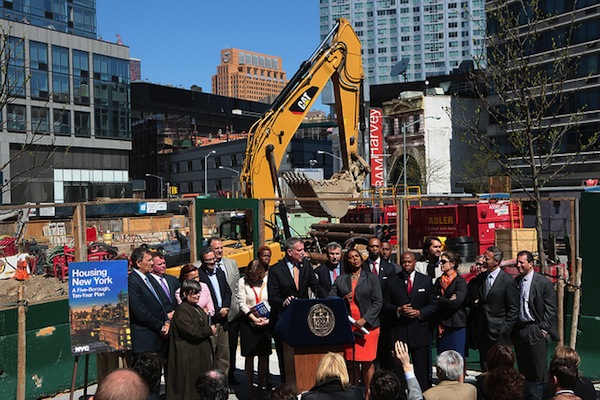
The unveiling of the mayor’s affordable housing plan in May 2014.
New York City’s expiring housing programs could lead to the loss of 234,520 affordable housing units by 2037, according to a report released last week.
The Association for Neighborhood and Housing Development report released Thursday also found housing units for extremely low- income households were not being preserved or created in line with the level of need in the city, and it credited nonprofit developers with creating and preserving more housing units for those extremely low-income households than for-profit developers.
The report, which examined housing development projects that receive city financial assistance from the city’s Housing Preservation and Development (HPD), aimed to determine whether the public is benefitting enough from the city’s investment in affordable housing. ANHD examined the public value of the affordable program by measuring the number of units built and assessing “the multiple ways in which housing is designed to meet neighborhood and city needs.”
“Every unit of affordable housing built or preserved with city-backed financing creates a benefit for the public. The level of benefit created by the affordable housing for the City and its local neighborhoods varies on who can access these units and whether they are being created for New York City’s most vulnerable populations,” ANHD wrote.
The methodology used data from 2015 to 2018–the first four fiscal years of the de Blasio administration–and includes 49,746 permanent rental affordable housing units. Data on homeownership units, supportive housing and housing units created under the city’s Mandatory Inclusionary Housing program was excluded.
The report found that 42 percent of the total units developed to date under the mayor’s plan, called Housing New York, were for low-Income households, those with incomes between 51 and 80 percent of Area Median Income (AMI), or roughly $58,000 to $77,000 for a family of three. Twenty-five percent were developed for Very Low-Income households, whose incomes are between 31 and 50 percent of AMI, roughly between $38,000 to $48,000 for a family of three; and 17 percent were built for Extremely Low- Income households, who make up to 30 percent AMI.
The distribution of units under the mayor’s plan, the report says, doesn’t match the distribution of households in the city, where over 41 percent of households fall within Very Low- and Extremely Low-Income tiers while Low-Income households only make up a little over 16 percent of the population.
“Housing New York is developing at deep levels of affordability,” the report read, “but not deep enough for New York’s needs.”
The city’s expiring affordable programs stem from past administrations some going far back as Mayor Ed Koch’s. “There is no way to accurately predict which of these units or how many will lose their affordability through a developer choosing to opt-out,” the report says.
The report also found that while for-profit developers got a larger share of the work created by Housing New York–75 percent of new construction units when compared with 25 percent for non-profits and 59 percent of preservation deals while non-profit developers had 41 percent–units for extremely low-income households made up a greater share of the non-profit portfolio.
The city’s Housing Preservation and Development said it disagreed with the report’s assessment of the city’s data.
“Preserving the affordability of this city’s neighborhoods is the cornerstone of the mayor’s ambitious Housing New York Plan. Since 2014, we have preserved over 91,000 affordable homes for New Yorkers, and we’re continuously working with our partners throughout the city to both create new affordable housing and lock in affordability wherever possible. This report uses a limited dataset and does not take a comprehensive look at what we’ve accomplished under Housing New York,” HPD said in an emailed statement to City Limits.
According to HPD, comparing the subsidies provided to for-profit and not-for-profit developers is difficult because both nonprofits and for profit developers receive public land and tax exemptions in addition to direct subsidies which was not accounted for in the ANHD report.*
The ANHD report recommended a few steps to create “a new framework” to maximize the value of affordable housing.
One is for the city to increase the depth of affordability targets, especially on city-owned land to serve those with the greatest need. And housing development projects on the publicly-owned land should be directly controlled by the city through all phases of the project from the Request for Proposal (RFP) process to completion, the report suggests.
Another recommendation was to increase the length of affordable housing for example creating and preserving more permanently affordable compared with short-term affordable housing especially for city-financed development projects. The report says, “Permanent affordability ensures that housing remains rent stabilized and affordable for households competing in an ever changing and challenging real estate market.”
The city does have programs in place to address some of those expiring agreements. According to HPD, the report excluded data on extended affordability agreements, such as standalone Article XI tax exemptions, which play a significant role in the preservation of affordable housing. It also did not include HPD’s affordability agreements which are structured to incentivize property owners to extend affordability at the end of a term. Additionally, the report did not mention that in many cases, rent stabilization ensures long term affordability after a regulatory agreement expires.
ANHD also recommended the city should increase opportunities for non-profit developers to build affordable housing because “mission-driven non-profit developers, compared to for-profit affordable housing developers, on average create a greater public value.”
*An earlier version reported for profits received public land and tax exemptions. HPD further clarified their response to City Limits to include both nonprofit and for profit developers as receiving public land and tax exemptions in addition to direct subsidies.









0 thoughts on “Report: City’s Housing Plan Goes Deep, But Not Deep Enough”
Pingback: Does NYC’s affordable housing program go far enough? | Real Estate Marketplace